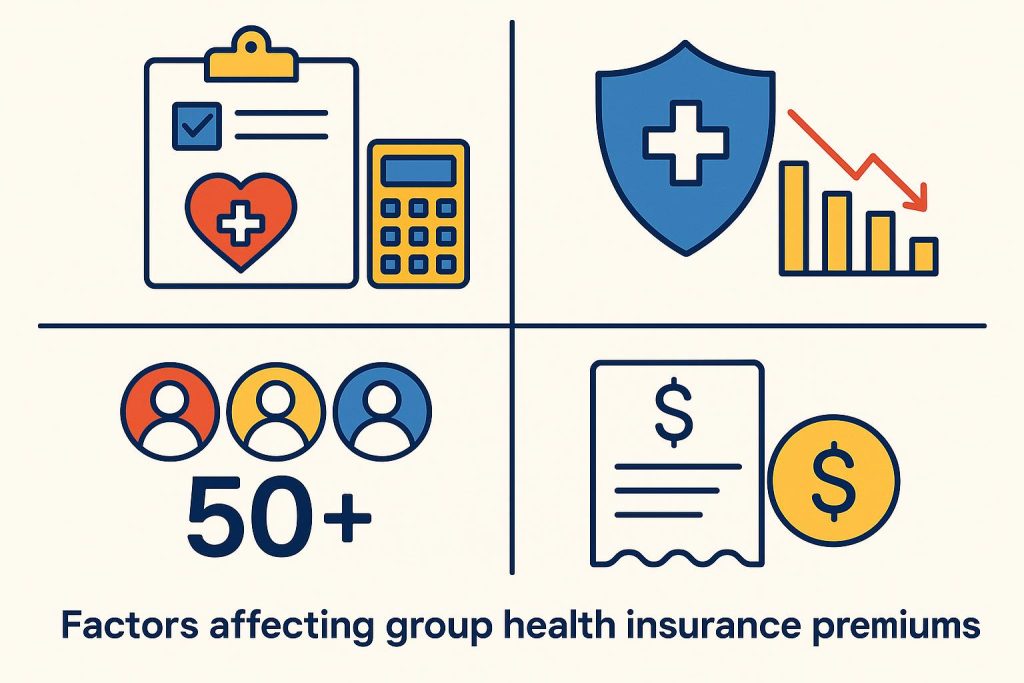You run a small company. Your employees work hard and you want to take care of them. So, you decide to offer group health insurance. However, when you look at the premium costs, you realise they vary. Why does one company pay less while another pays more for the same coverage? This is where understanding the factors affecting group health insurance premiums helps you plan better and manage costs effectively.
Factors influencing the cost of group health insurance
Five key factors that determine the premium for group health coverage are detailed below:
- Age
Suppose you have two different businesses. One has 10 employees aged 25-30. The other business also has 10 employees, but they are experienced professionals aged 50-55. In this case, the insurer will charge a higher premium for covering the group of employees with older ages. The reason is that the elderly are more susceptible to illnesses, especially lifestyle diseases, which can increase the liability of the insurer.
- Group size
The larger the group, the lower the premium per person. Insurers spread the risk across more people, ultimately reducing the impact of individual health issues. Let’s use an example to explain this:
Imagine you have a small team of 10 employees. In this case, the risk is concentrated among fewer people. If one of your employees has a pre-existing medical condition requiring frequent hospital visits, the insurer has fewer members to spread this cost. The result? They charge a higher premium per employee to balance the risk.
Now, let’s suppose your business grows, and you have 100 employees. Even if a few workers require expensive medical care, most may not claim during the policy tenure. The cost here is spread across a larger pool, resulting in a lower premium per person.
- Type of occupation
In the context of group health coverage, the risk varies depending on the type of business. For example, if you own a construction business, your employees will likely file claims due to accidental injuries. Additionally, prolonged exposure to asbestos, dust or diesel fumes can make your workers susceptible to lung disease or other severe illnesses. In this situation, the insurer may charge a higher premium for group health coverage.
On the other hand, if you run an IT business where most of your employees are software developers and have desk jobs, the risk of costly claims is significantly reduced. As a result, the insurer offers coverage at a lower cost.
- Number of claims
Suppose over the past year, several employees made frequent claims for hospitalisation, surgeries and chronic illness treatments. Due to this high-claim history, the insurer increases the premium when it is time to renew your group health insurance. This is because insurance companies assess risk, and if claims are high, they anticipate higher payouts and adjust the premium accordingly.
For example, suppose your company paid ₹5 lakh in premiums last year, but claims amounted to ₹8 lakh. The insurer sees this as a loss and hikes the renewal premium to around ₹6.5 lakh to compensate. Conversely, if claims were only ₹2 lakh, you might receive a better rate.
- Location of workforce
The group health coverage premium varies between urban and rural areas. For instance, if your office is situated in a metropolitan city like Mumbai, where healthcare services are expensive, the insurer will charge a higher premium to cover your employees.
Conversely, the insurer will charge only a lower premium if the office is located in a Tier 3 city, where affordable hospital services are available.
Tips to obtain a better rate on group health plan
Before buying or renewing group insurance coverage, consider the following tips to make the premium more affordable.
- Assess your employees’ healthcare requirements carefully to choose a plan that offers adequate coverage without unnecessary costs.
- Shop around and compare quotes from different insurance companies to find the best balance of cost and benefits for your team.
- Opt for plans that allow flexibility in coverage options so you can tailor benefits to fit your employees’ needs without paying for unnecessary extras.
- Not every add-on is meant for your organisation. If you purchase all without assessing your requirements, you will end up paying extra.
- Check if the plan you are purchasing covers preventive health checkups. This aspect is important as they can help reduce long-term healthcare costs by catching issues early.
- Larger groups often qualify for better rates, so consider the benefits of increasing employee participation to negotiate lower premiums.
- Don’t hesitate to negotiate directly with insurers to lower premiums or reduce administrative fees associated with managing the plan.
- Implement wellness programmes that encourage healthy lifestyles among employees. Insurers offer discounts for proactive health initiatives.
- Review past claims data to identify trends and adjust coverage accordingly. This proactive approach can help manage costs effectively.
Conclusion
Understanding the factors influencing group health insurance premiums is crucial for managing costs effectively. Factors such as age, group size, type of occupation, number of claims and location of the company significantly impact premium rates. By assessing these factors and implementing strategies like choosing the right coverage, comparing quotes and promoting wellness programmes, you can secure a better rate on your group health plan.




